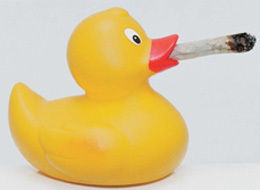It’s a gotcha story, lots of bugs, nothing that would really make anyone sick, but familiarity with a child and a bathtub (or an adult).
 Ceylan Yeginsu of The New York Times reports there’s an ugly truth about the rubber duck, the popular bathroom toy that children put in their mouths and use to squeeze bath water into their siblings’ faces.
Ceylan Yeginsu of The New York Times reports there’s an ugly truth about the rubber duck, the popular bathroom toy that children put in their mouths and use to squeeze bath water into their siblings’ faces.
Something yucky is likely to be inside, scientists say: “potentially pathogenic bacteria” that can cause eye, ear and stomach infections.
A study by American and Swiss researchers found that toy ducks appeared to be a breeding ground for microbes. The murky water released from four out of every five ducks tested included Legionella along with Pseudomonas aeruginosa bacteria, often associated with infections acquired in hospitals, the authors of the study said.
So don’t play with a rubber duck in a hospital.
 The study, conducted by the Swiss Federal Institute of Aquatic Science and Technology, ETH Zurich and the University of Illinois, was published on Tuesday in the journal N.P.J. Biofilms and Microbiomes.
The study, conducted by the Swiss Federal Institute of Aquatic Science and Technology, ETH Zurich and the University of Illinois, was published on Tuesday in the journal N.P.J. Biofilms and Microbiomes.
The researchers tested a range of bath toys, 19 different ones, and found 75 million cells of bacteria per square centimeter in the ducks — a strikingly high level that scientists say was a result of their polymer material releasing carbon, which acts as a nutrient for bacteria.
“In addition to the nutrient supply, dirty bath water also serves as a further source of microbial seeding for the bath toys,” the researchers noted.
They suggested that using a higher-quality polymer to make the rubber ducks might prevent bacterial and fungal growth.
The study, which received funding from the Swiss government, is part of broader research into bacteria on household objects.
